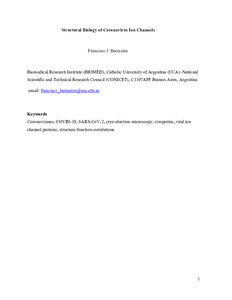Por favor, use este identificador para citar o enlazar este ítem:
https://repositorio.uca.edu.ar/handle/123456789/11364| Campo DC | Valor | Lengua/Idioma |
|---|---|---|
| dc.contributor.author | Barrantes, Francisco José | es |
| dc.date.accessioned | 2021-04-05T18:30:25Z | - |
| dc.date.available | 2021-04-05T18:30:25Z | - |
| dc.date.issued | 2021 | - |
| dc.identifier.citation | Barrantes F. J. Structural biology of coronavirus ion channels [en línea]. Posprint del artículo publicado en Acta Crystallographica Section D Structural Biology. 2021, 77 (4) Disponible en: https://repositorio.uca.edu.ar/handle/123456789/11364 | es |
| dc.identifier.issn | 2059-7983 | - |
| dc.identifier.uri | https://repositorio.uca.edu.ar/handle/123456789/11364 | - |
| dc.description.abstract | Abstract: Viral infection compromises specific organelles of the cell and readdresses its functional resources to satisfy the needs of the invading body. Around 70% of the coronavirus positive-sense single-stranded RNA encodes proteins involved in replication, and these viruses essentially take over the biosynthetic and transport mechanisms to ensure the efficient replication of their genome and trafficking of their virions. Some coronaviruses encode genes for ion-channel proteins – the envelope protein E (orf4a), orf3a and orf8 – which they successfully employ to take control of the endoplasmic reticulum–Golgi complex intermediate compartment or ERGIC. The E protein, which is one of the four structural proteins of SARS-CoV-2 and other coronaviruses, assembles its transmembrane protomers into homopentameric channels with mild cationic selectivity. Orf3a forms homodimers and homotetramers. Both carry a PDZ-binding domain, lending them the versatility to interact with more than 400 target proteins in infected host cells. Orf8 is a very short 29-amino-acid single-passage transmembrane peptide that forms cation-selective channels when assembled in lipid bilayers. This review addresses the contribution of biophysical and structural biology approaches that unravel different facets of coronavirus ion channels, their effects on the cellular machinery of infected cells and some structure–functional correlations with ion channels of higher organisms. | es |
| dc.format | application/pdf | es |
| dc.language.iso | eng | es |
| dc.publisher | C. S. Bond, University of Western Australia, Crawley, Australia | es |
| dc.rights | Acceso abierto | * |
| dc.rights.uri | http://creativecommons.org/licenses/by-nc-sa/4.0/ | * |
| dc.source | Posprint del artículo publicado en Acta Crystallographica Section D Structural Biology. 2021, 77 (4) | es |
| dc.subject | MEDICINA | es |
| dc.subject | BIOLOGIA | es |
| dc.subject | CORONAVIRUS | es |
| dc.subject | COVID-19 | es |
| dc.subject | SARS-CoV-2 | es |
| dc.subject | CANALES IONICOS | es |
| dc.title | Structural biology of coronavirus ion channels | es |
| dc.type | Artículo | es |
| dc.identifier.doi | https://doi.org/10.1107/S2059798321001431 | - |
| dc.identifier.pmid | 33825700 | - |
| uca.disciplina | MEDICINA | es |
| uca.issnrd | 1 | es |
| uca.affiliation | Fil: Barrantes, Francisco José. Pontificia Universidad Católica Argentina. Facultad de Ciencias Médicas. Instituto de Investigaciones Biomédicas. Laboratorio de Neurobiología Molecular; Argentina | es |
| uca.affiliation | Fil: Barrantes, Francisco José. Consejo Nacional de Investigaciones Científicas y Técnicas; Argentina | es |
| uca.version | publishedVersion | es |
| item.fulltext | With Fulltext | - |
| item.languageiso639-1 | en | - |
| item.grantfulltext | open | - |
| crisitem.author.dept | Instituto de Investigaciones Biomédicas - BIOMED | - |
| crisitem.author.dept | Laboratorio de Neurobiología Molecular | - |
| crisitem.author.dept | Facultad de Ciencias Médicas | - |
| crisitem.author.orcid | 0000-0002-4745-681X | - |
| crisitem.author.parentorg | Facultad de Ciencias Médicas | - |
| crisitem.author.parentorg | Instituto de Investigaciones Biomédicas - BIOMED | - |
| crisitem.author.parentorg | Pontificia Universidad Católica Argentina | - |
| Aparece en las colecciones: | Artículos | |
Ficheros en este ítem:
| Fichero | Descripción | Tamaño | Formato | |
|---|---|---|---|---|
| structural-biology-coronavirus-ion.pdf | 1,11 MB | Adobe PDF |  Visualizar/Abrir |
Visualizaciones de página(s)
70
comprobado en 27-abr-2024
Descarga(s)
285
comprobado en 27-abr-2024
Google ScholarTM
Ver en Google Scholar
Altmetric
Altmetric
Este ítem está sujeto a una Licencia Creative Commons

